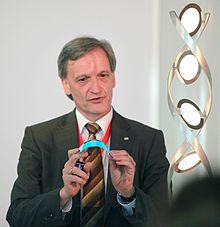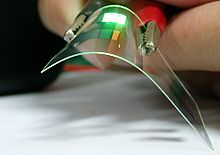- Flexible organic light-emitting diode
-
 Demonstration of a battery driven flexible OLED lamp from Merck KGaA
Demonstration of a battery driven flexible OLED lamp from Merck KGaA
A flexible organic light emitting diode (FOLED) is a type of organic light-emitting diode (OLED) incorporating a flexible plastic substrate on which the electroluminescent organic semiconductor is deposited. This enables the device to be bent or rolled while still operating. Currently the focus of research in industrial and academic groups, flexible OLEDs form one method of fabricating a rollable display.
Contents
Technical Details and Applications
See also: Organic LED: Working principleSee also: List of OLED AdvantagesAn OLED emits light due to the electroluminescence of thin films of organic semiconductors approximately 100 nm thick. Regular OLEDs are usually fabricated on a glass substrate, but by replacing glass with a flexible plastic such as polyethylene terephthalate (PET)[1] among others,[2] OLEDs can be made both bendable and lightweight.
Such materials may not be suitable for comparable devices based on inorganic semiconductors due to the need for lattice matching and the high temperature fabrication procedure involved.[3]
In contrast, flexible OLED devices can be fabricated by deposition of the organic layer onto the substrate using a method derived from inkjet printing,[4][5] allowing the inexpensive and roll-to-roll fabrication of printed electronics.
Flexible OLEDs may be used in the production of rollable displays, electronic paper, or bendable displays which can be integrated into clothing, wallpaper or other curved surfaces.[6][7][8] Prototype displays have been exhibited by companies such as Sony, which are capable of being rolled around the width of a pencil.[9]
Disadvantages
See also: List of OLED DisadvantagesBoth the flexible substrate itself as well as the process of bending the device introduce stress into the materials. There may be residual stress from the deposition of layers onto a flexible substrate[10], thermal stresses due to the different coefficient of thermal expansion of materials in the device,[11] in addition to the external stress from the bending of the device.[12]
Stress introduced into the organic layers may lower the efficiency or brightness of the device as it is deformed, or cause complete breakdown of the device altogether. Indium tin oxide (ITO), the material most commonly used as the transparent anode, is brittle. Fracture of the anode can occur which can increase the sheet resistance of the ITO or disrupt the layered structure of the OLED.[13] Although ITO is the most common and best understood anode material used in OLEDs, research has been undertaken into alternative materials that are better suited for flexible applications including carbon nanotubes.[14][15]
Encapsulation is another challenge for flexible OLED devices. While the common method of encapsulation for regular OLEDs is to seal the organic layer between glass, this is inappropriate for flexible OLEDs. The materials in an OLED are sensitive to air and moisture which lead to degradation of the materials themselves as well as quenching of excited states within the molecule. Flexible encapsulation methods are generally not as effective a barrier to air and moisture as glass, and current research aims to improve the encapsulation of flexible organic light emitting diodes.[16][17]
See also
- Active-matrix OLED
- Flexible electronics
- Organic light-emitting diode
- Phosphorescent organic light-emitting diode
- Rollable display
References
- ^ Gustafsson, G.; Cao, Y.; Treacy, G. M.; Klavetter, F.; Colaneri, N.; Heeger, A. J. (1992). "Flexible light-emitting diodes made from soluble conducting polymers". Nature 357 (6378): 477. doi:10.1038/357477a0.
- ^ MacDonald, W. A. (2004). "Engineered films for display technologies". Journal of Materials Chemistry 14: 4–10. doi:10.1039/B310846P.
- ^ Burrows, P. E.; Gu, G.; Bulovic, V.; Shen, Z.; Forrest, S. R.; Thompson, M. E. (1997). "Achieving full-color organic light-emitting devices for lightweight, flat-panel displays". IEEE Transactions on Electron Devices 44: 1188–1203. doi:10.1109/16.605453.
- ^ Hebner, T. R.; Wu, C. C.; Marcy, D.; Lu, M. H.; Sturm, J. C. (1998). "Ink-jet printing of doped polymers for organic light emitting devices". Applied Physics Letters 72: 519. doi:10.1063/1.120807.
- ^ Bharathan, Jayesh; Yang, Yang (1998). "Polymer electroluminescent devices processed by inkjet printing: I. Polymer light-emitting logo". Applied Physics Letters 72: 2660. doi:10.1063/1.121090.
- ^ Brandon Bailey (31 January 2011). "Flexible electronic display will get Army field test". Los Angeles Times. http://articles.latimes.com/2011/jan/31/business/la-fi-flexscreen-20110127. Retrieved 3 February 2011.
- ^ "'Light emitting wallpaper' could replace bulbs". BBC News. 30 December 2009. http://news.bbc.co.uk/1/hi/wales/8434705.stm. Retrieved 3 February 2011.
- ^ Michael Fitzpatrick (5 July 2010). "Haptics brings a personal touch to technology". BBC News. http://www.bbc.co.uk/news/10373923. Retrieved 3 February 2011.
- ^ Candace Lombardi (26 May 2010). "Sony unveils ultrathin rollable OLED". CNET News. http://news.cnet.com/8301-17938_105-20006000-1.html. Retrieved 3 February 2011.
- ^ Chiang, C.-J.; Winscom, C.; Monkman, A. (2010). "Electroluminescence characterization of FOLED devices under two type of external stresses caused by bending". Organic Electronics 11: 1870–1875. doi:10.1016/j.orgel.2010.08.021.
- ^ Hsueh, C. H. (2002). "Thermal stresses in elastic multilayer systems". Thin Solid Films 418: 182–188. Bibcode 2002TSF...418..182H. doi:10.1016/S0040-6090(02)00699-5.
- ^ Chiang, C.-J.; Winscom, C.; Bull, S.; Monkman, A. (2009). "Mechanical modeling of flexible OLED devices". Organic Electronics 10: 1268–1274. doi:10.1016/j.orgel.2009.07.003.
- ^ Leterrier, Y.; Médico, L.; Månson, J.-A. E.; Betz, U.; Escolà, M. F.; Kharrazi Olsson, M.; Atamny, F. (2004). "Mechanical integrity of transparent conductive oxide films for flexible polymer-based displays". Thin Solid Films 460: 156–166. doi:10.1016/j.tsf.2004.01.052.
- ^ Choi, K.-H.; Nam, H.-J.; Jeong, J.-A.; Cho, S.-W.; Kim, H.-K.; Kang, J.-W.; Kim, D.-G.; Cho, W.-J. (2009). "Highly flexible and transparent InZnSnOx/Ag/InZnSnOx multilayer electrode for flexible organic light emitting diodes". Applied Physics Letters 92: 223302. doi:10.1063/1.2937845.
- ^ Aguirre, C. M.; Auvray, S.; Pigeon, S.; Izquierdo, R.; Desjardins, P.; Martel, R. (2006). "Carbon nanotube sheets as electrodes in organic light-emitting diodes". Applied Physics Letters 88: 183104. doi:10.1063/1.2199461.
- ^ Han, J.-M.; Han, J.-W.; Chun, J.-Y.; Ok, C.-H.; Seo, D.-S. (2008). "Novel Encapsulation Method for Flexible Organic Light-Emitting Diodes using Poly(dimethylsiloxane)". Japanese Journal of Applied Physics 47: 8986–8988. doi:10.1143/JJAP.47.8986.
- ^ Liu, S.; Zhang, D.; Li, Y.; Duan, L.; Dong, G.; Wang, L.; Qiu, Y. (2008). "New hybrid encapsulation for flexible organic light-emitting devices on plastic substrates". Chinese Science Bulletin 53: 958–960. doi:10.1007/s11434-008-0088-9.
Categories:- Conductive polymers
- Display technology
- Electronic engineering
- Flexible electronics
- Molecular electronics
- Optical diodes
- Organic electronics
Wikimedia Foundation. 2010.


